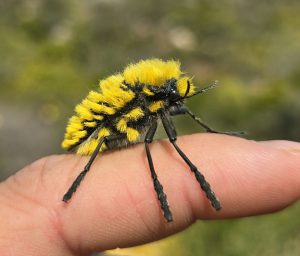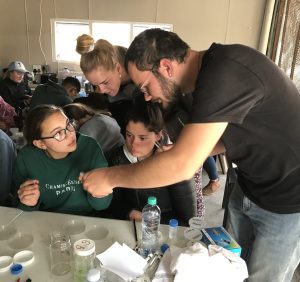Kraaifontein-born Renier Basson has been fascinated by insects for as long as he can remember. Growing up in an urban environment didn’t deter him; he was motivated to hunt for insects in his garden and sometimes on the school grounds.
Renier’s earliest experiences with insects included his discovery of the unusual ant-like insects in figs. Much later, during his undergraduate studies at Stellenbosch University, he realised these insects were fig wasps, essential for pollinating the figs. When he was seven, during his first rugby match, he became distracted by a black and yellow butterfly and chased it instead of playing the game. Later, he discovered similar caterpillars in his garden, reared them, and had a breakthrough moment when he realised, they were the same species as the butterfly he had once chased. Hearing these stories, it’s clear Renier was destined to become an entomologist.
Around 2005, Renier and his family moved to Clanwilliam, where he attended Augsburg Agricultural Gymnasium. In Grade 10, two representatives from Iimbovane visited his class to discuss biodiversity and sampling techniques for ants. Although ants weren’t his favourite, he was eager to learn.
“After the Iimbovane team’s visit to our classroom, I was more determined than ever to pursue a career in entomology, especially after I’ve learned that there is much more to the field of entomology than just finding cool bugs,” says Renier.
Inspired by this visit, Renier applied to study a BSc in Conservation Ecology and Entomology at Stellenbosch University, continuing to complete his Master’s degree in Entomology. For his Masters research, he chose to focus on an understudied insect group—South Africa’s native bark beetles—particularly those associated with the critically endangered Clanwilliam cedar trees (Widdringtonia wallichii) in the Cederberg. These beetles have a mutualistic relationship with fungi, dispersing it in exchange for assistance in breaking down plant material. His Masters project combined taxonomy, ecological interactions, and local biodiversity and led to the identification of nine new species: four bark beetles in the genus Lanurgus and five fungi in the genus Geosmithia.
In 2023, Renier offered his assistance with Iimbovane and joined one of Iimbovane’s weekend camps with Grade10 learners from his alma mater, Augsburg Agricultural Gymnasium. The camp, which took place in the Cederberg Wilderness Area, was a highlight for both the learners and Renier, who helped the learners to identify the beetles they collected in the area. Read more at: https://blogs.sun.ac.za/iimbovane/augsburg-leerders-bekyk-sederberg-blomplante-en-bestuiwers-van-nader/
While completing his Master’s, Renier worked ad hoc as a consultant for the Endangered Wildlife Trust (EWT). After graduation, he was offered a six-month contract, and currently he is a Senior Field Officer and Researcher in the Drylands Conservation Program. As the organisation’s only entomologist, he contributes to multiple projects.
“One of the projects I work on, include the study of threatened butterflies in the Western Cape. On another project, I do insect surveys on the peaks of the Langeberg Mountains to find endangered Cape stag beetles (Colophon) and develop conservation strategies. As part of my job, I also conduct biodiversity surveys and compile species lists for potential biodiversity stewardship sites in the Northern Cape,” explains Renier.
This career, he notes, comes with challenges. One of the biggest is persuading people that insects are as ecologically valuable as larger animals, like rhinos or wild dogs. Insects are often misunderstood and seen as pests, partly due to lack of knowledge and partly because they are often perceived as unappealing. Fieldwork presents further challenges, especially when studying highly threatened Cape stag beetles on mountain peaks accessible only by helicopter. These beetles are also targeted by poachers for the insect collection market, making monitoring and protection even more complex.
“Unfortunately, climate change is one of the biggest threats to localized threatened species. Where can they possibly go? Climate is changing more rapidly than ever, and species are not able to adapt to this rate of change. So, climate change mitigation is still a headscratcher for us,” adds Renier.
Asked about the future of entomology, Renier described his excitement at the field’s endless possibilities. South Africa’s insects are understudied compared to those in other regions While many local entomologists focus on pest control, Renier is passionate about native species, particularly fireflies (Lampyridae).
Renier advice to aspiring entomologists:
“Build as many connections as possible. You will always need someone outside of your field, because entomology is one of those fields that fits right into the middle of anything in the biodiversity/ecology fields. And get to know your species, even though it can get tricky at times. I’m still finding my way in wildlife conservation, but if you consider taking this route – be humble and open-minded. Lastly – remember to use sunscreen in the field. Don’t be stubborn like me – skin cancer is real!”
|
|
|

